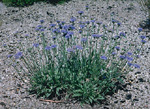 |
Brunonia australis is the only species in this endemic family (which
should probably be included in Goodeniaceae). It is found almost throughout
Australia except in the monsoon and wet tropics, in open vegetation usually
on light-textured soils.
Characteristic features of the family Brunoniaceae in Australia include: - herbs with basal, obovate leaves
- flowers bright blue, in dense heads on the ends of tall, unbranched scapes
- corolla tubular with 5 erect or spreading lobes
- stamens connate to form a tube around the style, which ends in a 2-lipped (indusiate) style-end
Description
Annual or perennial terrestrial herbs perennating by taproots.
Vegetative reproduction absent or rarely by stolons. Internal secretions
not obvious. Plants with simple, non-glandular, uniseriate hairs. Leaves
alternate and spiral, all or mostly basal, subsessile. Stipules absent.
Lamina simple, symmetric, elliptic, oblanceolate or obovate; base attenuate;
margins entire, ±flat; one-veined, with the midrib conspicuous,
and the tertiary venation not reticulate; surfaces not punctate; herbaceous.
Plants with all the flowers bisexual. Inflorescences terminal, consisting
of capitula. Bracts and bracteoles present. Pollination by insects. Flowers
odourless or fragrant; sessile. Floral disc absent; nectaries present
on the carpels. Perianth regular, of 2 dissimilar whorls. Calyx segments
fused, with 5 lobes, open in bud; calyx bell-shaped; herbaceous or papery.
Corolla segments fused, with 5 lobes, alternating with the calyx lobes,
imbricate in bud; corolla tubular, blue, without contrasting markings,
membranous; lobes ±entire. Fertile stamens 5, opposite to the calyx
lobes, at least partly fused to the corolla, free of the ovary and style,
fused by their anthers, all ±equal. Anthers basifixed, not versatile,
opening inwards by longitudinal slits; 2-celled. Ovary superior and sessile.
Carpels 2, fused; ovary with 1 locule. Style terminal, single and unbranched
and the stigma obscurely 2-lobed. Ovule 1, stalked; placentation basal.
Fruit a dry, indehiscent nut; the perianth on the maturing fruit deciduous
or dry and persistent. Disseminule macro-surface with a pappus of hairs;
micro-surface ±smooth, white or brown, dull. Seeds 1 per fruit.
Aril absent. Cotyledons 2. Embryo straight.
(Note: this description has been generated from the coded data compiled for the key. Any errors in the key data will be reflected in the descriptions.)
A treatment of the family Brunoniaceae has been published in:
Flora of Australia 35: 13.
Australian genera of Brunoniaceae (as recognised for the Flora of Australia)
Brunonia

|
  |

Brunonia australis (flowering plant)
Photo: G.Butler © ANBG
|
 |
|